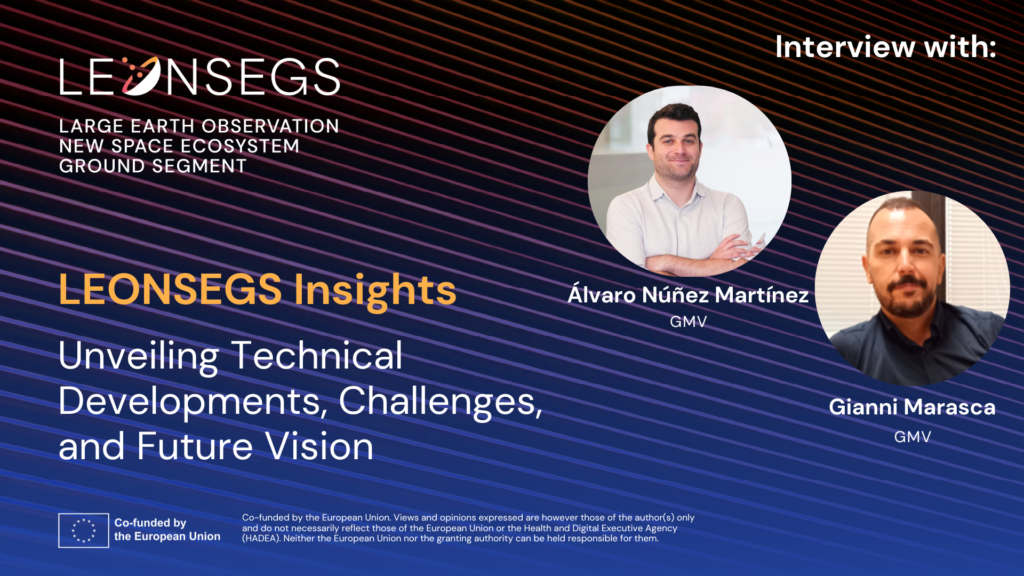Dive into our latest interview with Álvaro Núñez Martínez and Gianni Marasca from GMV. They provide a comprehensive overview of the LEONSEGS project, discussing its current progress, upcoming milestones, and technical innovations. Discover the challenges expected and the strategies being implemented to overcome them, as well as the exciting use cases and the project’s long-term vision for the future of Earth Observation data utilisation.
The LEONSEGS project is completing 21 months of work, with another 15 more yet to come. Looking ahead, what are the key milestones, technical developments or other that you’re most excited about?
Álvaro: In 2025, one of the most exciting milestones for LEONSEGS is the validation of external EO provider tasking, particularly through our collaboration with Aistech and its Flatsat platform. This will allow us to test how LEONSEGS can request new acquisitions from external satellite operators. Successfully integrating Aistech’s capabilities into LEONSEGS will be a key step toward enabling multi-provider EO services.
Additionally, we are advancing in mission planning and scheduling functionalities, improving coordination between satellite tasking, data acquisition, and product generation. Another key development is the expansion of satellite tasking via GSaaS, allowing operators to plan and execute mission requests within the LEONSEGS framework.
Another major development is the enhancement of data search and retrieval mechanisms, with a focus on integrating semantic search capabilities. This will improve how users discover and access EO products, moving beyond conventional metadata-based searches toward more intelligent, context-aware queries.
These technical improvements will push LEONSEGS toward becoming a fully interoperable EO service orchestration platform, capable of harmonising diverse data sources and delivering advanced insights to users across different domains.
LEONSEGS aims to create a harmonised interface through which diverse EO data providers can collaborate all together. What challenges have you encountered so far in achieving this, and how will 2025 address them?
Álvaro: One of the main challenges in achieving a harmonised interface has been the interoperability of different EO data sources. Providers use different data formats, metadata standards, and access protocols, which demands considerable effort to ensure a smooth and consistent user experience. Standardising these interfaces is key to overcoming this barrier. Another critical challenge is the integration of external EO product providers, where tasking and acquisition planning depend on third-party systems with their own constraints and availability.
In 2025, we will address these challenges by refining our integration framework to better standardise interactions with external providers. This will include improving metadata translation mechanisms and introducing ontology-based search to enhance data discoverability, integrating multiple data sources. Furthermore, by working closely with federated EO providers such as Aistech, we aim to establish standardised tasking and data retrieval workflows that can be extended to other providers in the future, facilitating more efficient and scalable integration.
And what are the biggest challenges you anticipate facing in the final phase of the project?
Álvaro: As LEONSEGS progresses toward its final phase, one of the biggest challenges will be ensuring scalability and robustness as we integrate more EO providers and services. The system must be capable of handling an increasing number of user requests, a broader variety of product types, and growing data volumes without compromising performance. Additionally, integrating GSaaS for satellite mission onboarding, monitoring, and control services remains a complex task. This involves not only the effective onboarding of new satellite systems but also the continuous monitoring of satellite health and mission status in real-time. Coordinating telemetry data, ensuring timely tasking, and providing responsive control are critical for maintaining mission integrity. As we scale, ensuring compatibility and efficient communication between various satellite providers’ systems and our own infrastructure will require careful orchestration.
LEONSEGS platform aims to coordinate and produce for the end-user complex EO products. What use cases are being considered in the project and what other sectors do you anticipate benefiting the most from LEONSEGS?
Gianni: LEONSEGS has identified two key use cases to test its prototype and showcase the platform’s capabilities. The first involves vineyard owners, who will select specific parcels, past time periods, and desired resolutions to access historical EO images. These images will reveal trends in vine vigor and nutritional status. LEONSEGS will search through various catalogues to deliver relevant EO imagery, aiding in better vineyard management. This use case will demonstrate how LEONSEGS can optimise agricultural practices and provide valuable insights to vineyard owners.
The second use case involves agricultural cooperatives. Agricultural analysts will define specific cereal field areas and time periods to request EO images. LEONSEGS will combine semantic queries with metadata searches and coordinate satellite tasking to provide high-resolution images for moisture condition analysis and agricultural planning. This use case will highlight LEONSEGS ‘s ability to support detailed agricultural analysis and effective planning.
Looking ahead, LEONSEGS aims to expand into environmental monitoring, urban planning, disaster response, and maritime surveillance. These future applications will enhance tracking deforestation, land use analysis, rapid damage assessment, and ship detection, showcasing LEONSEGS’ versatility and potential to support informed decision-making across various sectors.
Beyond June 2026, what are the long-term goals and aspirations for the LEONSEGS platform?
Gianni: Beyond June 2026, the long-term goals and aspirations for the LEONSEGS platform are ambitious and forward-looking. Our primary objective is to advance the development of LEONSEGS, transforming it from a prototype into a fully commercialisable solution. We aim to launch LEONSEGS into the market, making it accessible to a wide range of potential customers and partners.
Our vision is to establish LEONSEGS as a leading federated platform in the field of Earth Observation in Europe, providing valuable insights and data to various sectors. By continuously enhancing the platform’s capabilities and expanding its applications, we intend to meet the evolving needs of our users. We are committed to working diligently towards these goals, ensuring that LEONSEGS becomes a trusted and indispensable tool for decision-makers across industries.
We believe that LEONSEGS has the potential to make a significant impact, and we are dedicated to realising this vision.


